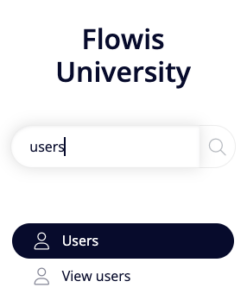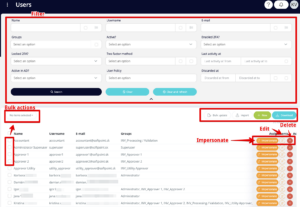
If anybody wants to access Flowis, see the Transactions, Definitions and make actions, he has to have his account created in Users. Here you can set up the details for his signing up, his preferences regarding language, time, date, or amount formats, or set up his Groups which will grant him wished Permissions in Flowis.
In the list of Users you can see various options that can be done with Users:
- Filter – you can filter among Users using whichever attribute you need
- Impersonate – this button allows you to see Flowis exactly as this selected User sees it. The permission to impersonate other Users is only available to administrator roles, but can be granted also to basic Users via User policies
- Bulk actions – when you check one or more Users, you can perform these actions on them:
- Activate – make the Users active, therefore able to sign in
- Deactivate – make the Users inactive, therefore unable to sign in
- Disable 2FA authentication – the two-factor authentication will not be required when signing in
- Enable 2FA authentication – the two-factor authentication will be required when signing in
- Reset expired password – if the password has expired (the expiration is set up in User policies), you can re-activate it here (so if the expiration is 90 days, this action will make the password valid for another 90 days)
- Reset 2FA authentication – if the User is not able to verify (e.g. he has a new phone), this reset will show him a new QR code which he can use to pair his mobile phone with his account in Flowis
- Send initial password link – an e-mail with a link to set up the first password will be sent. The link only works for 10 days
- Send reset password link – an e-mail with a link to set up a new password will be sent. The link only works for 48 hours
- Edit – manually edit this selected User
- Delete – permanently delete this selected User
- Bulk update – update various Users at the same time.
- Fields – check which fields will be used to identify which Users should be updated
- Username (CN) – Common Name from LDAP
- Username (SAM – Account Name) – Account Name from LDAP
- E-mail – e-mail address
- Name – name set in the tool
- Users – insert all of the Users that you want to update using their Usernames / E-mails / Names (depends on what you checked in the previous field)
- Separator – choose what will separate the Users in the previous field – e.g. new line or comma
- Add group ids – Users will be added to these selected Groups
- Remove group ids – Users will be removed from these selected Groups
- Add new users? – all bulk updated Users who are not part of the tool yet will be created
- The Test button lets you see the update before applying it to the Users. The Submit button applies the changes to the Users.
- Fields – check which fields will be used to identify which Users should be updated
- Import – import the list of Users from the Excel file
- New – manually create a new User
- Download – download the list of Users (if the filter is active, only Users who apply to the filter will be downloaded)

General setup
Each User consists of the following attributes:
- Name – full name of the User
- Username – will be used to sign up to the tool, needs to be lowercased and unique for every User
- E-mail – needs to be unique for every User
- Password – you can set a password for the User here
- Password confirmation – type in the password again to confirm it
- Groups – select all of the Groups this User should be part of
- Personal groups – each User has its own Personal group, and each User should be only part of his own Personal group
- E-mail addresses – e-mail addresses in this field do not need to be unique for every User. When using Assignments, the action will be assigned to the Personal group of every User whose e-mail address is either in the E-mail field (above) or this E-mail addresses field
- Two-factor authentication – signing in will be conditional on two-factor authentication
- Role – role of User which grants him certain permissions in Flowis – for more info about each role, read our article about Permissions
- Job title, Department, Country, Company name, Office location, Mobile phone – information to keep the database of Users complex, the data will not be used or shown anywhere in the tool
- User principal name – User’s name from Active Directory (usually the username)
- Manager – you can select another User to be this user’s manager. In Workflows, when using “Assign to based on field” callback, you can then escalate the Assignment to the manager from this field
- User Policy – select the User policy that should apply to this User
- Active? – non-active User will not be able to sign in to Flowis
- Super-admin? – this grants super-user admin access with all possible permissions and overrides some security measurements. This allows the user to execute any Ruby code and see technical error messages. This should be used only for debugging purposes and granted only to trusted Senior Engineers.
- Discarded at – if the User did not sign in to the tool in 90 days, his account will expire and the expiration date will be written in this field. It can be set manually too. After this date, the User will not be able to sign in. Deleting the expiration date will enable him to sign in again.
Profile setting
Here you can set up personal preferences for each User:
- Profile picture – upload a .jpeg, .jpg, or .png file that will be shown in the Transaction’s history after hovering over the User’s name. File size mustn’t exceed 10MB.
- Time zone – all actions on Transactions will be transformed to this time zone. The default is Europe/Bratislava
- Date format – all dates on Transactions will be transformed to this format. The default is MM/DD/YYYY (11/25/2023)
- Time format – all times on Transactions will be transformed to this format. The default is 24 hours with seconds (18:53:21)
- Amount format – all amounts on Transactions will be transformed to this format. The default is EU – 2 decimals (12 345,67)
- After action redirect to – after performing an action on Transaction, you can be redirected either to your Action list, to the next Transaction, or stay in the current Transaction’s detail
- Language (locale) – which language should be used in the tool
- Default dashboard – which dashboard should be seen on the homepage by default